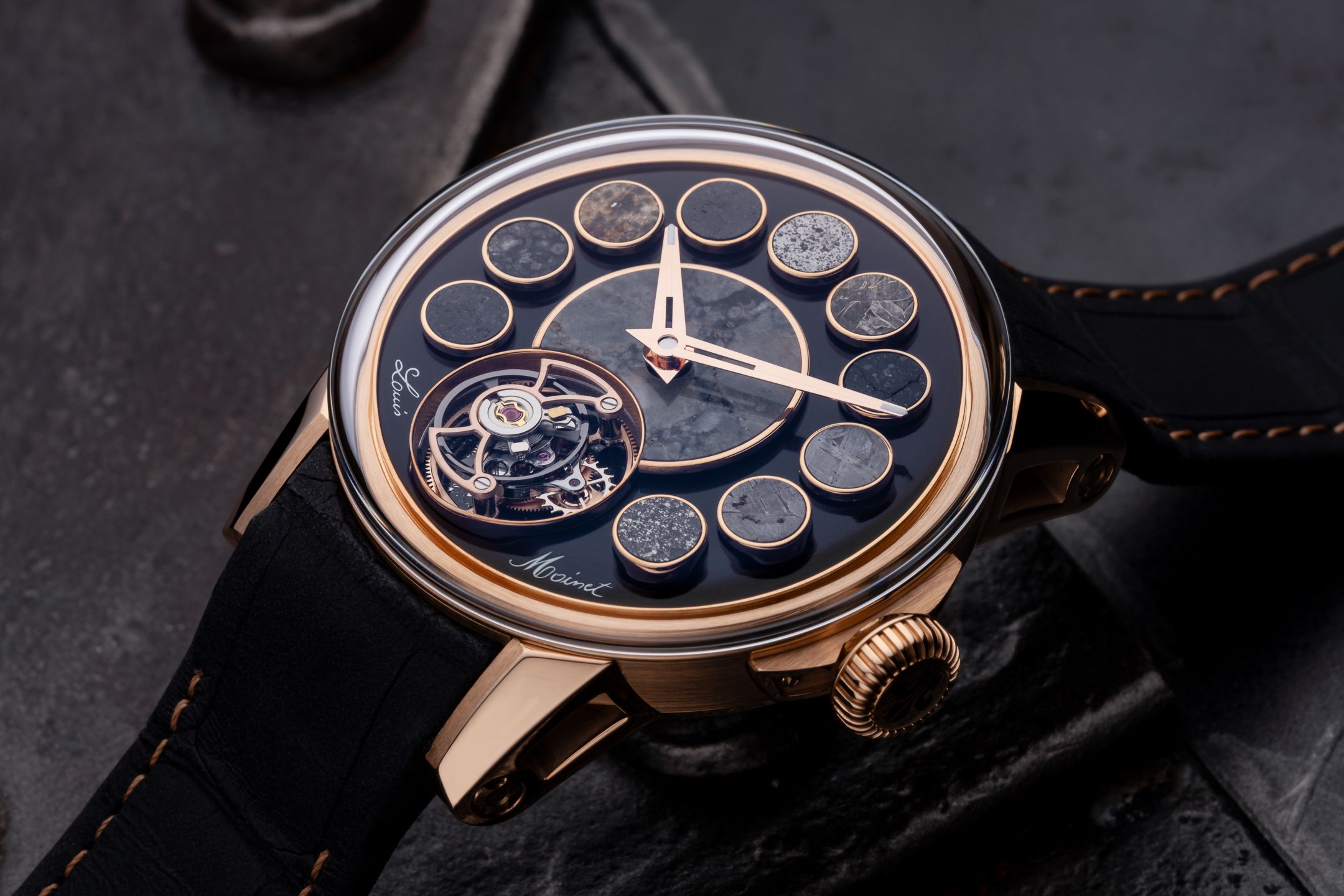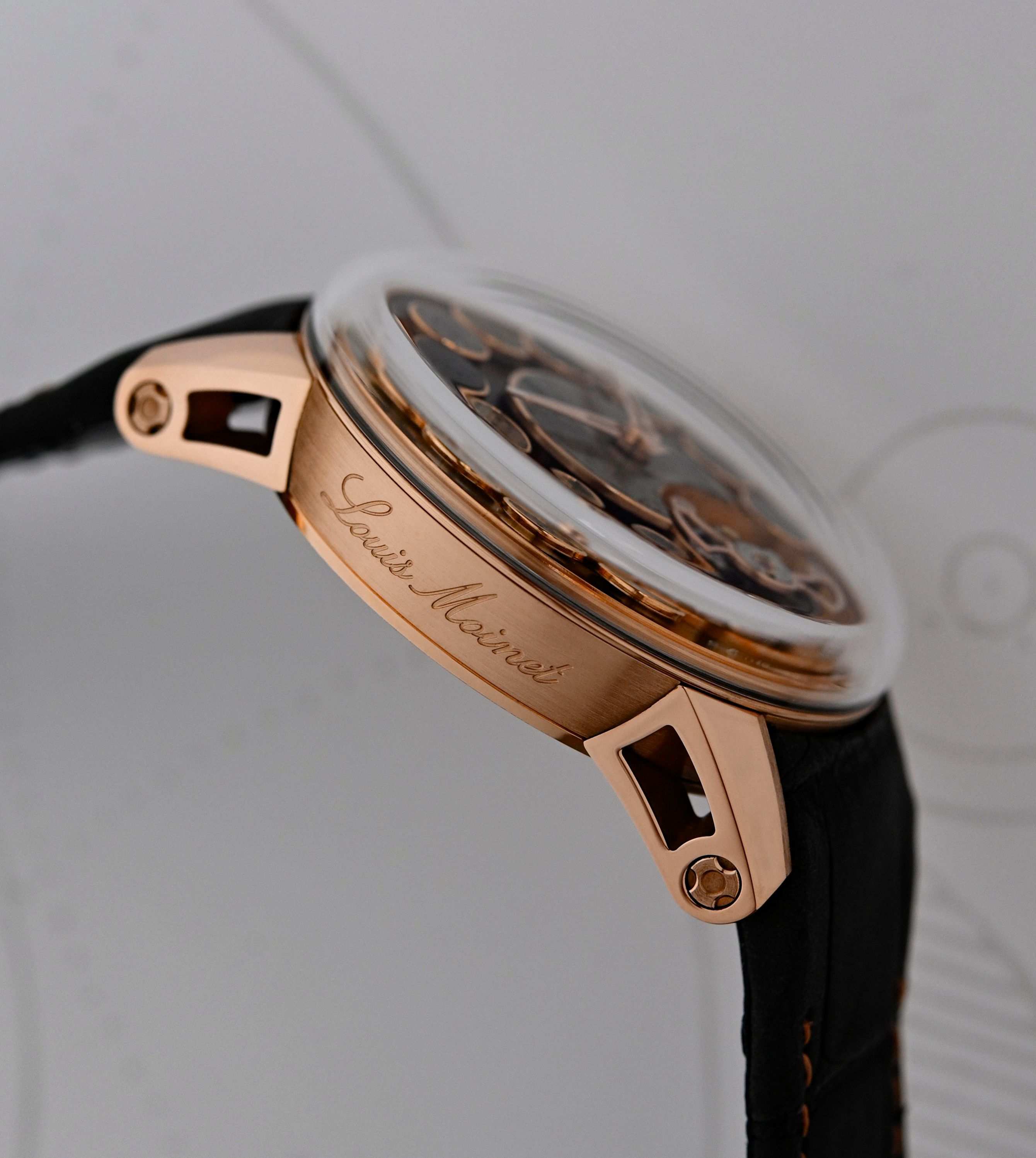Is It A Real Meteorite On Your Dial? Jean-Marie Schaller Decodes The Making Of Meteorite Dial Timepieces
When it comes to pushing boundaries and redefining horological art, Louis Moinet is in a league of its own. The brand's latest creation, the Cosmopolis, is a cosmic marvel that leaves traditional watchmaking in the dust. Forget about simple meteorite dials – this timepiece brings the heavens to your wrist with not one, but twelve exquisite fragments of space-traveled meteorites adorning its face.
Each sliver of these galactic gemstones is a tangible piece of the vast cosmos, having journeyed millions of miles before finding its resting place on this extraordinary watch. The Cosmopolis doesn't just incorporate meteorites; it embraces them in a way no other timepiece has before, earning it the Guinness World Record for the most meteorite inserts on a watch.

We caught up with Jean-Marie Schaller to understand where these meteorite materials come from, about the dials, and more!
THM: Can you talk me through the full process of how you source and acquire fragments of meteorites? How do you verify their authenticity?
Jean-Marie: I've been collecting exceptional meteorites for twenty years, among them are some of the most beautiful specimens in the world. I work with meteorite hunters who, over the years, have become true friends.

Consequently, all the meteorites we use are indeed authenticated and systematically recorded. In fact, each of their discoveries undergoes thorough scientific analysis. As a result, each identified meteorite is given a name and a sort of 'identity card', which are published in The Meteoritical Bulletin of the Meteoritical Society. For each meteorite discovered, a collected sample is allocated for scientific research. These samples are crucial for conducting detailed analyses and establishing their classification. Subsequently, they are preserved in institutes or museums as reference specimens.
THM: Have you faced any challenges or criticisms for using rare meteorite materials? How do you respond to concerns about sustainability or over-mining of meteorites?
Jean-Marie: We transform meteorites into the rarest works of art! We are committed to ensuring that the creation of our pieces results from a beautiful, human story, filled with strong values. It is important to note that meteorites are extraterrestrial materials, and therefore, their use does not lead to over-mining or exploitation of Earth's resources. Meteorites are collected either after 'falls', which means shortly after they have landed on Earth, or through 'finds', sometimes long after their fall. Furthermore, we only work with a small network of responsible and respectful professionals who adhere to established regulations.
THM: How much does the rarity or composition of a meteorite impact the price and exclusivity of the finished luxury watch? How do you determine pricing?
**Jean-Marie: **Rarity: With approximately forty types of existing meteorites, the rarest and most coveted ones are the lunar and Martian meteorites. For instance, the rare lunar meteorite Dhofar 461 is featured in our Super Moon timepiece, while the Martian meteorite is used in our Mars Mission model!
Scientific Interest: Because meteorites are scientific objects! Most of them are around 4.5 billion years old and can originate from the far reaches of the solar system. For example, the Allende meteorite is the oldest rock in the solar system, while the Jbilet Winselwan meteorite exhibits the earliest signs of life in the universe!

Aesthetics: With meteorites like the lunar Gadamis 005, which specialists agree is one of the most beautiful meteorites ever to come from the moon. It takes center stage on the dial of our JULES VERNE TO THE MOON creation. Similarly, the Sahara 97093 stands out with its microdiamond structure and is part of the 12 meteorites in the COSMOPOLIS timepiece We can also mention the famous distinctive Widmanstätten pattern of the Gibeon meteorite, which is typical for extraterrestrial ferrous rocks.
Provenance and discovery location: For instance, for this year's Doha Jewellery and Watches Exhibition, we are presenting a unique watch incorporating the first meteorite ever discovered in Qatar, the Qatar 001 meteorite! Finally, the possibility of polishing meteorites for use in watchmaking is another factor to consider. When cut, only a few, due to their aesthetic qualities, are suitable for use in watchmaking.
THM: Do you collaborate with astrophysicists or meteoriticists to learn more about the origins and compositions of your materials?
Jean-Marie: We work with Luc Labenne, one of the world's most famous meteorite hunters; he is a global specialist in meteorites! Thanks to his analyses and those conducted for the official registration of meteorites, we obtain valuable information about their origin, composition, and rarity. Through these findings and engaging exchanges with meteorite hunters, we learn the unique stories hidden behind each meteorite. It is these fascinating stories that were the creative spark that gave birth to the COSMOPOLIS, the renowned timepiece that earned the prestigious title of "most meteorite inserts in a watch" from the GUINNESS WORLD RECORDS.

THM: What kind of chemical stabilization or protection do you apply to the meteorite dials to prevent degradation over time? How durable are they?
Jean-Marie: We only select meteorites that do not oxidize or deteriorate. A special treatment is performed on certain extraterrestrial ferrous rocks such as Gibeon, in order to reveal its distinctive Widmanstätten pattern.
THM: How are meteorite dial watches perceived and selling compared to your other high-end models? What customer profile typically buys them?
Jean-Marie: LOUIS MOINET's timepieces are perceived as true works of horological art, distinguished by their rarity and captivating history. They are collector's items, attracting those who seek to own a piece of both astronomical and horological history. There is no typical profile for our customers, but they share a common trait: the desire to fulfill a childhood dream, one that involves possessing not only an unprecedented high watchmaking mechanism but also a fragment of humanity's history. I like to think of it as the bridge between the time measured by our timepieces and the cosmic time of the universe—an ultimate way to connect every moment of life to the timeless saga of the universe.

They also appreciate the link with Louis Moinet's rich history. Indeed, Louis Moinet designed the first chronograph in history for use in his astronomical observations called " Compteur de Tierces" to be able to observe the movements of stars through a telescope accurately. His invention enabled him to measure the exact distance of the reticule lines of his telescope. Louis Moinet was timing the passage of stars, planets, and even planetary moons. A frequency of 216,000 v/h imparted 60 vibrations a second, thus dividing the second into sixtieths. He made the computer initially to set the precise distance between the crosshairs in his telescope, as he describes in his Traité d’Horlogerie (1848)
THM: If offered many controversial Antarctic meteorites, would you consider using them? Why or why not?
Jean-Marie: Never. At the core of Louis Moinet lies a strong ethic, guiding our collaboration exclusively with partners who share our values of responsibility and sustainability. My passion is to share fascinating stories with clients about time, our world, and the universe. These narratives can only be authentic if everyone contributing to this beautiful journey also subscribes to this deep respect for our environment and the precious resources it holds.

THM: Have you considered using meteorite materials for other watch components besides dials? What possibilities exist?
Jean-Marie: The meteorite must be protected from external factors, which is why it is typically placed inside the watch, beneath the sapphire crystal. However, how meteorites are creatively incorporated into Louis Moinet watches can vary. At times, they are positioned under the tourbillon cage, enclosed in a capsule, integrated onto the main plate, used as hour markers or as raised elements, or even adorn the center of the dial. For instance, in the case of Cosmopolis, 11 out of the 12 meteorites are arranged on small platforms, each one elevated by a stand, providing them with a deserving pedestal. The 12th meteorite is positioned behind the tourbillon.

Defying the constraints of Earth's gravity, the Cosmopolis houses a sophisticated tourbillon complication, a mesmerizing dance of precision timekeeping. This unique blend of otherworldly materials and intricate mechanics is a testament to Louis Moinet's unparalleled artistry and boldness.
In true Louis Moinet fashion, the Cosmopolis is a boldly avant-garde statement piece that shatters conventions. It's a wearable cosmic journey, a triumph of innovation over tradition, and an audacious exploration of what's possible when boundaries are pushed in haute horlogerie.
No articles found





